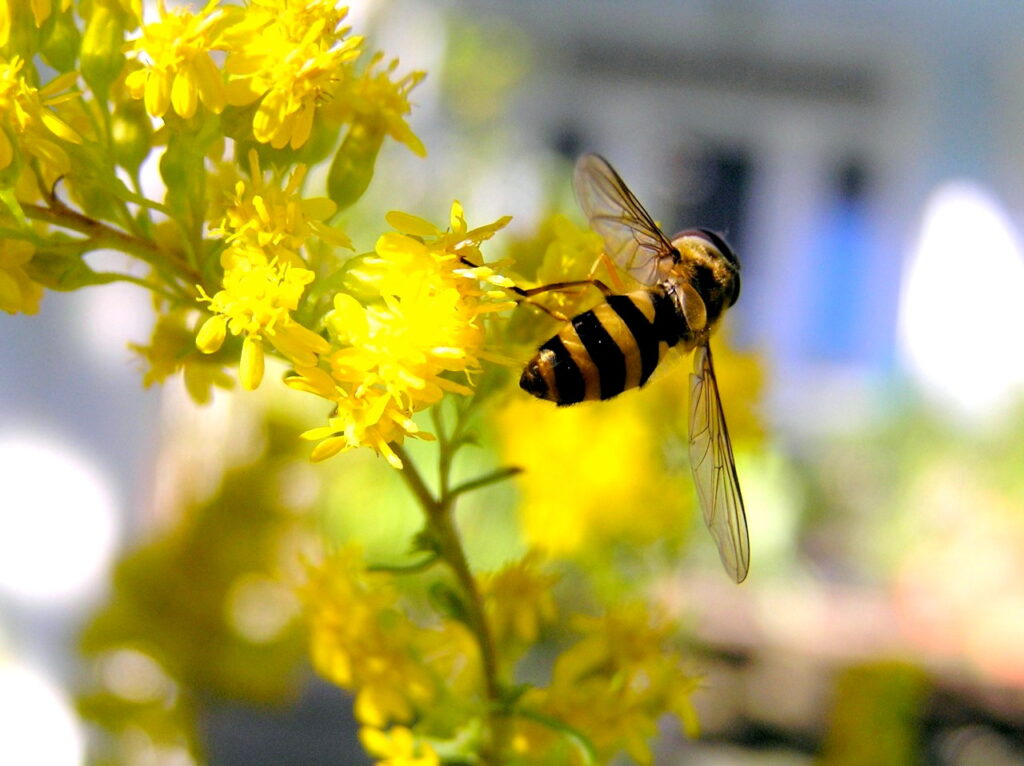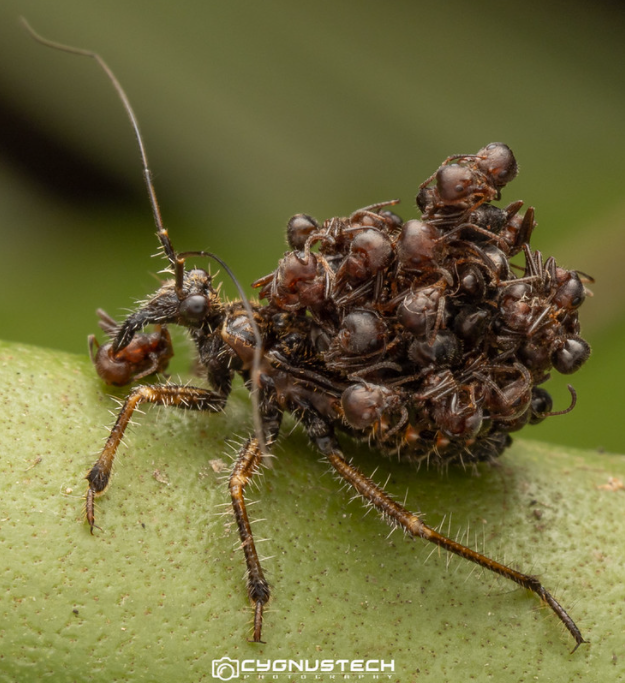By Sharon Selvaggio, Pesticide Program Specialist, The Xerces Society
More and more people in our Bee City USA and Bee Campus USA communities are recognizing that flowering plants provide food for bees and butterflies. But did you know that adding flowers also enhances natural pest control? Yes, it’s true! Many beneficial insects that eat or parasitize pests also consume pollen or nectar during a portion of their lives. So adding flowers for pollinators can attract these beneficial insects, having the added benefit of reducing pest damage to your landscape and garden plants.
In her book, Attracting Beneficial Bugs to Your Garden, Jessica Walliser describes fighting her urge to call a pest control company after seeing aphids covering the leaves of her backyard tulip tree, a prized source of shade. Knowing that pests like aphids often attract “natural enemies”, she decided to wait for two weeks, and watched for natural enemies to come in to fix the problem. And they did—within two weeks lady beetles of all life stages were busy gorging themselves on the aphids. Three days later, the aphids were gone.

Plants actually call for help in this amazing process! Scientists have figured out that plants getting attacked by herbivorous insects emit chemical signals called HIPVs (herbivore-induced plant volatiles). These waft into the air and lure in predatory and parasitic insects to come to the rescue.
When we think about predatory species and their prey, we often visualize large animals such as wolves and sheep or owls and mice. Similarly, when we think about parasitic species, we are likely to imagine species that infect humans, like tapeworms. But nature is chock full of predatory and parasitic relationships in the insect world—which work to our benefit. In fact, insect natural enemies contribute an estimated $4-12 billion in value to American agriculture each year. They are important in our towns and cities, too.
If this comes as a surprise to you, you’re not alone. Frequently, these natural enemies are small and unobtrusive, and thus go unnoticed. Add that to the dominant culture that erroneously teaches us to believe insects of all kinds are somehow repugnant…and of course few of us know about or appreciate these creatures. But this attitude is misguided, because it’s estimated that less than 2% of all insect species are considered pests; the rest are of direct value to humans or to food webs and ecosystems.
Two kinds of natural enemies to know about include predators, which hunt and kill their prey, and parasitoids. Parasitoids lay their eggs on or inside their hosts, which include pest species. The eggs hatch into larvae, which develop inside the pest, keeping it alive…only as long as the parasitoids need to complete development. At that time, the parasitoids cause the death of the host as they emerge.
Let’s look at a few examples of these relationships.
Among predators, a bizarre favorite is the assassin bug. Just thinking about being a small insect prey item of this ferocious predator hurts. You could expect to be forcibly injected with digestive enzymes that will dissolve your internal organs. As you lay dying you could then expect the assassin bug to finish sucking the life right out of you. To add insult to injury, you might even have your dead carcass slung over the assassin bug’s back, like some Trojan war trophy, as it hunts another victim.

Flower flies (also known as Syrphid flies—or hover flies because they can hover like a hummingbird) are another important predator. Adult flower flies superficially resemble the coloration of some bees and wasps. The larvae effectively attack pests much larger than themselves while adults feed on pollen and nectar.
Parasitoids feed on hosts while developing, ultimately killing their hosts (as contrasted with parasites, who keep their hosts alive without killing them). Parasitoid wasps are all around us, and comprise possibly the most diverse insect group worldwide.

Do you have aphids on your plants? Look closely and see if you can find aphid “mummies” – papery brownish husks of dead aphids, containing a large exit hole. That’s the sign of a parasitoid that has emerged from its aphid host, leaving the host dead.
Don’t forget, many natural enemies need pollen or nectar, so adding flowers for bees or butterflies also lays the groundwork for a healthy population of natural enemies that will control pests. Given that many natural enemies overwinter in leaf litter, leaving some of your autumn leaves on the ground through the winter will help support these insect allies. Sometimes leaves can also attract slugs and snails, so to protect your early season sprouts, “leave the leaves except near the peas.”
Another thing to keep in mind is that natural enemies are sensitive to pesticides, just like other insects. In fact, one concerning effect of pesticides is that they can annihilate not just the target pest but also the natural enemies who are our helpful allies in controlling pests. When natural enemies are killed by a pesticide application, a resurgence of the original pest and/or a secondary pest outbreak is common. A bad situation can get even worse.
Landscapes without much natural or semi-natural habitat are likely to have more severe pest issues because predators and parasitoids are not present in large enough numbers. For example, yards with large expanses of manicured lawns and only a few types of ornamental shrubs provide neither food nor shelter for predators and parasitoids (or other wildlife). Outbreaks of bagworms, lacebugs, or other common pests that cause unsightly defoliation of ornamental shrubs and trees often occur in these simplified landscapes.
Going back to those amazing cries for help, now we know that plants can help themselves, tolerating some pest damage. This is really important…it means that a little exposure to pests actually makes plants more resilient!
So there you have it. One more reason why a landscape that includes and prioritizes diverse species of flowering, native plants is a great idea. One more reason to realize that fear of insects is unwarranted. One more reason to appreciate the marvelous complexity of the natural world we inhabit.
As an educated gardener, you can help others recognize these indispensable relationships, and learn not to reach for the spray bottle as soon as a bug is seen. Not only might it be dangerous to our community’s bees, but it probably is completely unnecessary. Give a little time for the natural enemies to come in and do their work.
Resources:
Bee City USA. Bee City USA® and Bee Campus USA work to galvanize communities to sustain pollinators, in particular the more than 3,600 species of native bees in this country, by increasing the abundance of native plants, providing nest sites, and reducing the use of pesticides. Bee City USA and Bee Campus USA are initiatives of the Xerces Society for Invertebrate Conservation. Find out more at beecityusa.org.
Your Insect Allies: Meet the Beneficial Allies Controlling Pests in Your Garden. This informative presentation by The Xerces Society biologist Jennifer Hopwood introduces common natural enemies and outlines strategies you can implement at home to support their needs.
Attracting Beneficial Bugs to Your Garden: a Natural Approach to Pest Control, by Jessica Walliser. This book is a gem, loaded with useful information about natural enemies and facts about the intricate interactions between garden plants and beneficial insects.
Farming with Native Beneficial Insects. This beautiful, illuminating book by The Xerces Society is designed to help farmers and anyone else understand, protect and enhance habitat for native beneficial insects that provide ecological pest control solutions.





